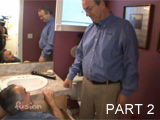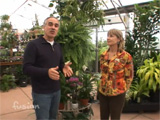|
EPISODE #91 -
SATURDAY SEPTEMBER 24, 2011
Welcome to
fall! David loves this time of year and I think it is because
he is a chef. He looks forward to getting back inside because
of the weather changes and whipping up some comfort food in the
kitchen. I have to tell you, when we have show planning
meetings, we always vote on meeting at David’s! Yum! Of course
the rest of the crew would like to hold on to this warm weather
for just a few more weeks. There is still time to catch some
‘rays’ and enjoy some quality hammock time before we have to
worry about cold weather, right?
Enchilada Sauce Chef David
returns to the kitchen to share another recipe that uses our
basic tomato sauce that we prepared a few weeks ago (check out
the Tomato sauce recipe here). We started by tearing up,
removing the seeds and soaking some New Mexico chilies.
Remember when you are working with chilies, peppers or other
spicy foods to wear gloves or wash your hands. You don’t want
the oils to get into your eyes by accident. This recipe also
uses white onion, garlic, and some chicken stock. You start by
sweating down the onions (cooking out the moisture) then we add
the garlic, the chicken stock and the tomato sauce. After a few
minutes the peppers are added and once they are allowed to
simmer you can blend and strain the mixture to get a great sauce
that you can use on chicken or cheese enchiladas.
For the full recipe you
can check it out here.
Food ‘Old Wives Tales’ We have
all heard the saying ‘an apple a day keeps the doctor away’, but
is that really true? To get the lowdown on the truth to this
story and some of the other popular food myths we contacted food
expert and author
Elizabeth Somer. We met her at the Community Health
Education Center at Salem Hospital in their demonstration
kitchen where they teach classes in healthy eating because it
seemed like the perfect setting for this topic. She covered 5
of the top myths and we found out some very interested ‘facts’.
Most of the myths, like ‘fish is brain food’ and ‘carrots are
good for your eyesight’, are totally correct. But there are
other foods that can give you more of the same healthy compounds
and are not so popular. For example, the myth that ‘tomatoes
are an aphrodisiac’ is true, but did you know that, cup for cup,
watermelon has just as much of the important compound as
tomatoes? To learn more about food and healthy eating check out
Elizabeth’s books ‘Eat your way to Happiness’ and ‘Age-Proof
your Body’ or go to her website for healthy eating tips and
recipes.
Replacing your Faucet - Part 2 Last week
Robin picked out a new faucet and David picked up the tools.
This week David gets a little help with the installation! Dave
from
George Morlan (503-224-7000) came out to get David some
tips. First shut off the water under the sink and disconnect
the water supply tubes. Use a bucket to catch the water that
leaks out of the tubes. Next disconnect the pop-up assembly
which operates the drain. Remove the clips and screws that hold
the old faucet on to the sink and lift it out. You should have
the faucet removed now, but we still need to remove the drain.
The new drain will have the same finish as the new faucet so you
need to do this so they both match. Remove the trap from under
the sink. There will be a lot of water in this so make sure you
have a bucket handy. Take the rest of the pop-up assembly off
and then loosen the nut and remove the old drain assembly from
the sink. The sink
should be bare of all hardware now. Use some cleaner to remove
the hard water stains before you begin to install the new
faucet. To start, insert the new faucet in the hole and line it
up so it is straight. Then make sure your fittings are ready
for the water supply lines at the bottom of the faucet. Next,
install the new drain. Be aware of the opening for the
overflow. It has to line up with the overflow discharge holes
in the sink. Adjust the drain so it fits snug and use some
plumber’s putty to create a watertight seal. Install the new
pop-up assembly and we are ready for the next step; reconnecting
the water supply. Use your Teflon tape on the new connectors
and then attach them to the water supply tubes. Install the new
drain at this time as well. Once everything is assembled and
tightened you can turn on the water. Run the water for 1-2
minutes and check for leaks. Tighten nuts and use more putty if
you see leaks. This is a
job that can be done by one person in a weekend. If you want to
try doing this we recommend that you stop by George Morlan to
get the faucet, tools and tips you need for the job. They
really made it easy!
Indoor NASA Plants
NASA has expanded our learning in lots of
different fields, and not just the fields of science. They have
also found out a lot about the different types of plants and
their uses. We caught up with Deby at
Cornell Farm
(530-292-9895) to talk to her about the recent NASA findings
about indoor plants. She told us that NASA investigated the use
of indoor plants as a means of cleaning the air in the space
station. They came up with some interesting results. They
found that indoor plants are great at absorbing toxins in the
air. Chemicals like formaldehyde, benzene, and
trichloroethylene can be taken up by certain plants and that can
make your living space healthier. Common household items like
carpet, paint, insulation, cleaners, plastics and detergents all
can release toxins into your home. Philodendrons, Boston ferns,
spider plants, mums and gerbera daisies are just a small
selection of plants that can help your air stay clean. To see
these and many others you can stop by Cornell Farm and talk to
their staff. |
   
 |
|||
|
Website design and content ©2009-2011 Gustin Creative Group.
Please send website inquiries to
gustingroup@comcast.net. |














